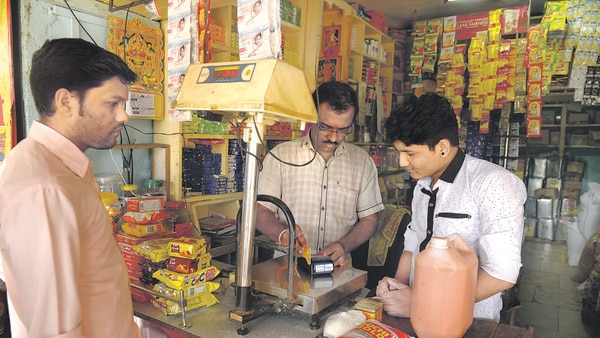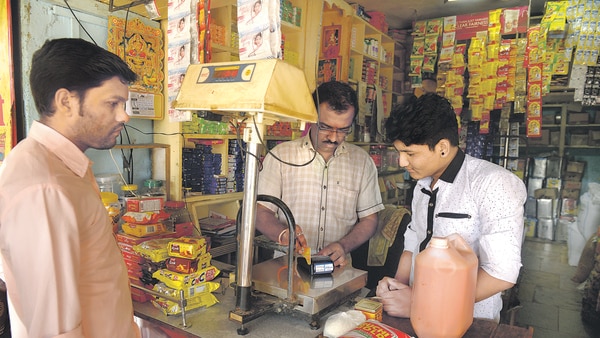
A homemaker in Coimbatore who used to buy groceries from the neighbourhood store now simply orders online what she needs the night before, to be delivered at 7am. It arrives on time, just after her morning puja, every day and she pays her bill at the end of the month using her mobile wallet. The e-store that delivers her groceries customizes reminders and options, almost seeming to know what she will need before she realizes it.
In Lucknow, a grocery store owner orders online his stock; it’s delivered in 24 hours, reducing capital and space requirements, and freeing him up from daily trips to the wholesale market.
This is the contemporary scenario of grocery retail, and it is an exciting time to be a retailer and a consumer in India. The overall India grocery market is set to grow from about $550 billion to nearly $1 trillion in four to five years. Of this nearly 60% is fresh produce—fruits, vegetables and meat—where FMCG (fast-moving consumer goods) brands don’t really play. The addressable market for FMCG players, therefore, is about $250 billion today, and estimated to double in the next four to five years, according to Bain & Co.
INFLECTION POINT
Future scenarios in grocery retail will be determined by how key uncertainties evolve. We see three significant trends: First, wholesale will become more organized as players like Reliance, Walmart and Metro invest to grow. Additionally, e-commerce horizontals like Amazon and third-party logistics players could enter in a big way, further boosting the shift towards organized wholesale.
Second, e-commerce, direct-to-consumer (D2C) models, supermarket chains and kiranas-turned-independent-self-service stores will significantly outgrow existing channels and formats, especially in the top 40 urban towns. Despite policy limitations, we expect e-commerce players to continue to invest in grocery to drive customer acquisition and frequency.
Third, by 2030 nearly 31 boom towns and developed rural areas will drive consumption, premiumization will make hitherto niche segments viable to address, and consumers will be more open to using different technologies for discovery, browsing and shopping, according to a report titled The Future of Consumption in Fast-Growth Consumer Markets: India published by World Economic Forum and Bain and Co. in January.
The progress of these locked-in trends will depend on how two uncertainties play out—one, the pace, extent and direction of regulation and policies governing foreign and domestic investment in multi-brand retail, logistics and the food value chain; two, how quickly and extensively FMCG companies and consumers adopt different technologies.
In this backdrop, we have evaluated four scenarios for the future. The first scenario is the age of behemoths where large retail companies thrive in investment and market environments that are conducive for rapid growth. However, consumer and supplier technology adoption is still relatively slow. Organized wholesale and B2C, especially offline/omnichannel, take off but are not dominant, and rural market thrives with investments in the food value chain and logistics.
The next is the two-speed systems scenario where D2C and e-commerce thrive, and consumers use digital technologies for discovery and shopping.
Companies have to manage two-speed systems, traditional trade and wholesale, and an emerging organized retail ecosystem.
In the third consumer nirvana scenario, the entire value chain undergoes massive organization across wholesale, retail and consumer levels. Rural India thrives and D2C models and consumer-facing technologies take off as well.
Finally, the fourth scenario is a linear progression, where the extent of modernization and organization of retail and trade, and the use of technology by consumers and suppliers remain low. These scenarios will become visible in the next two years but will play out over three to six years and will partially depend on policy changes.
CHALLENGES FOR FMCG
FMCG players will have to operate differently, regardless of which of these scenarios emerge. We see the need to re-design offers and marketing mixes, re-invent route-to-market strategies and re-invest in technology. Companies will have to handle the complexity of co-existing organized and unorganized wholesale and retail channels, emerging e-commerce and D2C models, and different locations of consumption.
Adding to this complexity is the fact that some of these channels will be sub-scale but with high growth, and have different requirements from traditional trade. In the two-speed systems and consumer nirvana scenarios, we foresee the traditional distributor-led model being replaced with partnerships with specialists in logistics, payments/financing, software, manpower management and consumer engagement.
Notwithstanding which of the scenarios play out, one thing is certain: The market will be more complicated and it will not be for the faint-hearted to navigate. Scale, performance, products, differentiation, cost, technology and people will be key challenges an FMCG player will need to work through.
DATA AND INNOVATION
As you consider above trends, think about the abundance of data that is just beginning to fuel the innovation engine. Companies are discovering creative ways to transform existing operations, enrich customer experience and create new businesses. Brands and players benefit from digital design tools that reduce development time and cost, advanced analytical approaches, and in-store technology that offers innovative ways to engage and build loyalty with customers.
Advanced analytics is enabling fast-moving consumer goods players to drive not only their last-mile efficiencies, but also to increase their revenue through the hyperlocal route.
Many organizations are piloting or scaling up technology-enabled shifts such as predictive ordering, personalized consumer and customer marketing, voice-activated sales aids and dashboards, and augmented and virtual reality to create new consumer experiences at stores.
As fast-moving consumer goods players move away from a traditional distributor-led system, front-line executives will need to manage multiple partners and stakeholders at the local level. Specialist providers of technology, logistics, financing/payments, outsourced manpower and CRM (customer relationship management ) systems call for managers who can take a long-view to building assets, not just exploit them for quarterly and yearly returns.
In the coming decade, India will move towards being the third largest economy in the world with a significant millennial population. The retail industry will have bountiful opportunities for growth but only the brave-hearted will survive. India will see hypermarkets and supermarkets in a more pervasive manner.
Kirana stores that were condemned to extinction will see a new afterlife. Brick-and-mortar stores will thrive along with online and virtual stores.
For consumers, there will be greater personalization, transparency and competitive pricing. For employees, there would be need for re-skilling and more jobs. The government will have to support the industry with policies and progressive tax reforms especially at the level of the states.
Joydeep Bhattacharya is a partner at Bain and Co. and heads its India consumer products and retail practices. Sanjay Wali is with Godfrey Phillips India.

